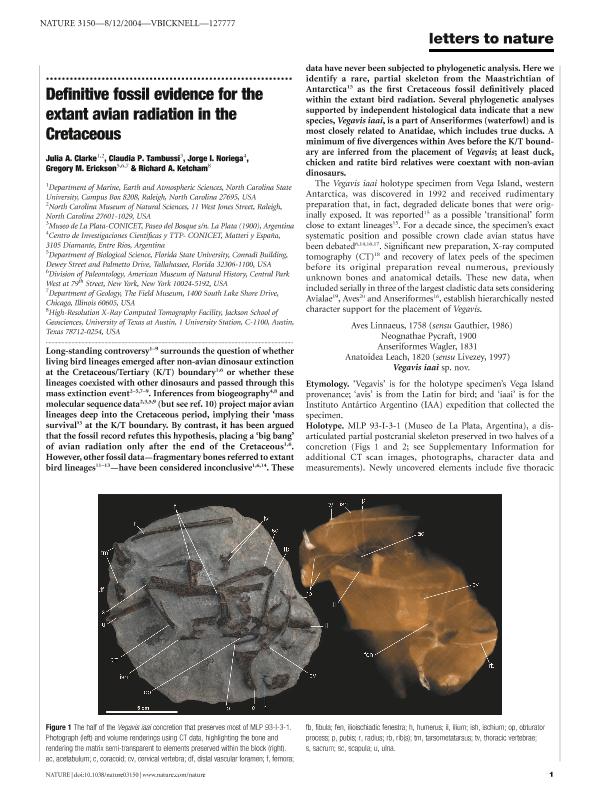Artículo
Definitive fossil evidence for the extant avian radiation in the Cretaceous
Clarke, Julia A.; Tambussi, Claudia Patricia ; Noriega, Jorge Ignacio
; Noriega, Jorge Ignacio ; Erickson, Gregory M.; Ketcham, Richard A.
; Erickson, Gregory M.; Ketcham, Richard A.
 ; Noriega, Jorge Ignacio
; Noriega, Jorge Ignacio ; Erickson, Gregory M.; Ketcham, Richard A.
; Erickson, Gregory M.; Ketcham, Richard A.
Fecha de publicación:
01/2005
Editorial:
Nature Publishing Group
Revista:
Nature
ISSN:
0028-0836
Idioma:
Inglés
Tipo de recurso:
Artículo publicado
Clasificación temática:
Resumen
Long-standing controversy 1-9 surrounds the question of whether living bird lineages emerged after non-avian dinosaur extinction at the Cretaceous/Tertiary (K/T) boundary1,6 or whether these lineages coexisted with other dinosaurs and passed through this mass extinction event2-5,7-9. Inferences from biogeography4,8 and molecular sequence data2,3,5,9 (but see ref. 10) project major avian lineages deep into the Cretaceous period, implying their 'mass survival' 3 at the K/T boundary. By contrast, it has been argued that the fossil record refutes this hypothesis, placing a 'big bang' of avian radiation only after the end of the Cretaceous1,6. However, other fossil data-fragmentary bones referred to extant bird lineages11-13-have been considered inconclusive1,6,14. These data have never been subjected to phylogenetic analysis. Here we identify a rare, partial skeleton from the Maastrichtian of Antarctica15 as the first Cretaceous fossil definitively placed within the extant bird radiation. Several phylogenetic analyses supported by independent histological data indicate that a new species, Vegavis iaai, is apart of Anseriformes (waterfowl) and is most closely related to Anatidae, which includes true ducks. A minimum of five divergences within Aves before the K/T boundary are inferred from the placement of Vegavis; at least duck, chicken and ratite bird relatives were coextant with non-avian dinosaurs.
Palabras clave:
Aves
,
Radiation
,
Cretaceous
,
Antarctica
Archivos asociados
Licencia
Identificadores
Colecciones
Articulos(CICYTTP)
Articulos de CENTRO DE INV.CIENT.Y TRANSFERENCIA TEC A LA PROD
Articulos de CENTRO DE INV.CIENT.Y TRANSFERENCIA TEC A LA PROD
Citación
Clarke, Julia A.; Tambussi, Claudia Patricia; Noriega, Jorge Ignacio; Erickson, Gregory M.; Ketcham, Richard A.; Definitive fossil evidence for the extant avian radiation in the Cretaceous; Nature Publishing Group; Nature; 433; 7023; 1-2005; 305-308
Compartir
Altmétricas



